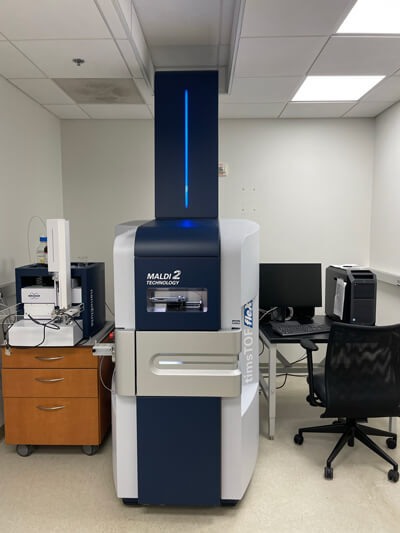News
15 April 2025
Light sheet microscopy: A decade-long journey from DIY innovation to cutting-edge imaging
A look at the technology that provides researchers with deeper insights into complex biological systems.
Read Article
News
Charles Banks is a scientist in the Stowers Institute’s Systems Mass Spectrometry Technology Center. We sat down with him to learn more about a new instrument Stowers members have access to—the timsTOF flex MALDI-2.

The distribution of 15 different ions over a section of rat brain.
What is mass spectrometry and how can it paint a picture of biology?
Mass spectrometry can uncover the molecular composition of a biological sample. Specifically, a MALDI instrument first uses a laser beam to ionize or charge molecules in the sample. After passing through the instrument, the charged molecules reach a mass analyzer where unique “mass-to-charge” ratios are measured. By matching these measured values to theoretical values in a database, the molecules can be identified. In MALDI imaging, we can color code these different molecules and generate images that map their location across a slice of tissue.

timsTOF flex MALDI-2
What does the timsTOF flex MALDI-2 do?
The timsTOF flex MALDI-2 can be used to identify a range of biomolecules including lipids, metabolites, and proteins. In contrast to our existing technology, the new instrument can analyze not only liquid samples but also solid samples such as tissue sections. Consequently, we can now map the distribution of these biomolecules across tissues at a resolution of 50 micrometers, approximately the size of a grain of sand or the width of a single strand of hair. This process is also referred to as Imaging Mass Spectrometry.
What is the benefit of having this technology at Stowers?
The new technology will allow researchers to map the distribution of large numbers of different biomolecules in tissues. For example, this could allow identification of groups of biomolecules specific to diseased tissue or subsets of biomolecules important for fundamental biological processes such as regeneration.
What are you most looking forward to about having access to this technology?
As the name implies (“flex”), the new instrument is flexible. Using ion mobility, this instrument is far more sensitive, allowing us to characterize proteins from a single cell. Previously, protein analysis by mass spectrometry relied on much larger samples prepared from thousands of cells. This will open new avenues for research and will be exciting to observe differences in the proteome from one cell to another.
Can you describe a few collaborations that your team has utilized this technology in?
We are increasingly collaborating with the other Technology Centers here at the Stowers Institute. For example, we coordinate with the Histology team to prepare tissue sections on slides prior to MALDI imaging. Single cell proteomics analyses involve collaboration with Cytometry for cell sorting, and Automation for the robotics technology needed for small-scale sample preparation.
News
15 April 2025
A look at the technology that provides researchers with deeper insights into complex biological systems.
Read Article
News
11 April 2025
“There are few rewards as powerful and as elevating as making a clear, robust scientific observation that advances the field.”
Read Article
News

09 April 2025
New study shows how we can better learn our genome’s hidden grammar, potentially paving the way for personalized medicine.
Read Article
